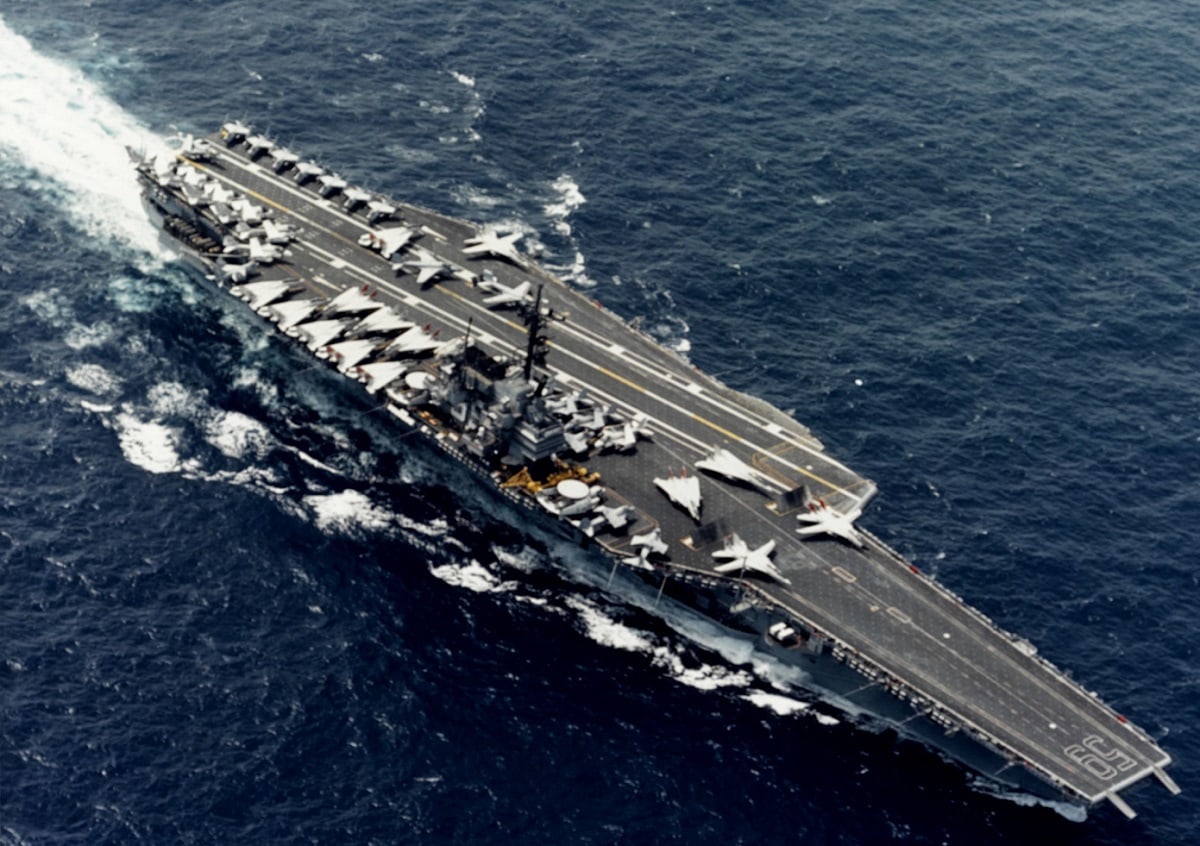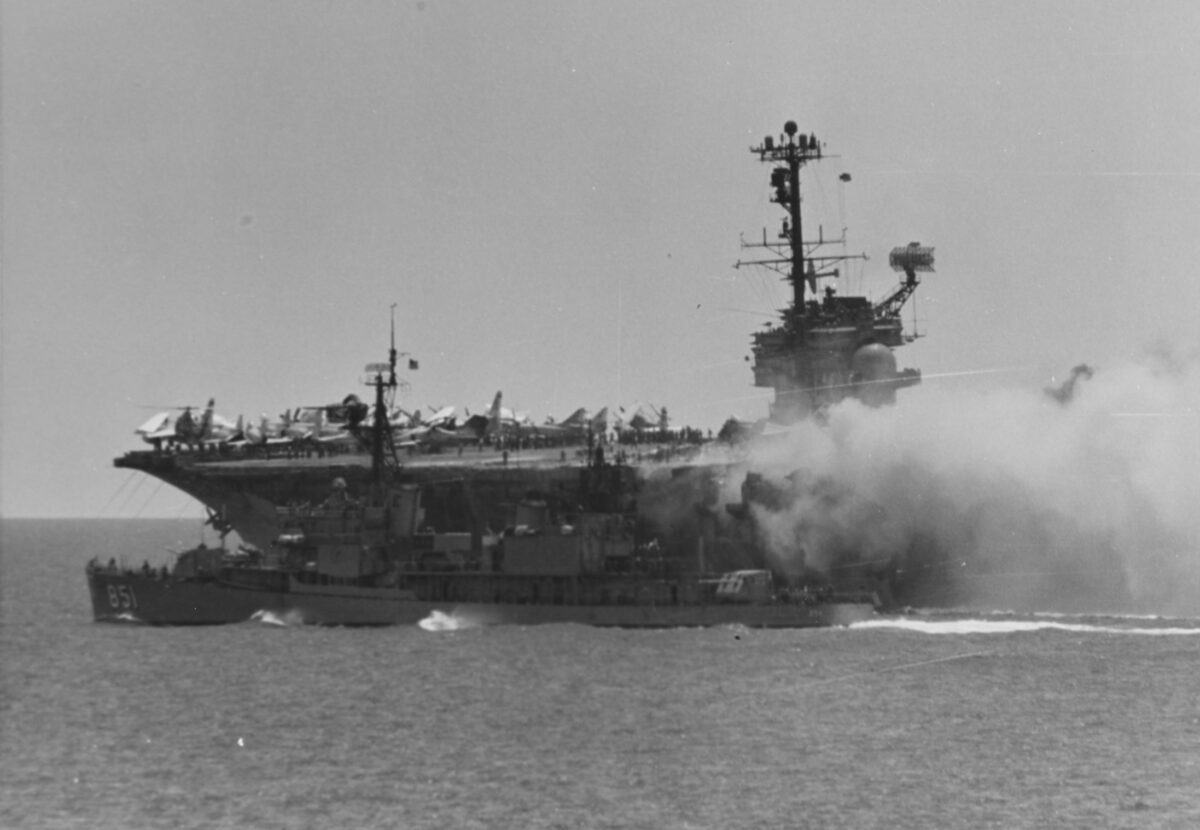Key Points: The 1967 fire aboard the USS Forrestal aircraft carrier remains one of the US Navy’s worst disasters. Triggered during Vietnam War operations by an accidentally launched Zuni rocket hitting a fuel tank, the incident sparked a massive jet-fuel fire on the flight deck.
-Subsequent ordnance explosions intensified the inferno, killing 134 sailors, injuring 161, destroying 21 aircraft, and severely damaging the carrier.
-Contributing factors included unstable ordnance stored on deck and initial difficulties in firefighting.
-The tragedy prompted vital investigations and led to significant, lasting reforms in naval ordnance handling, firefighting training, equipment, and safety protocols.
The USS Forrestal Aircraft Carrier Fire
The 1967 fire on the USS Forrestal aircraft carrier was one of the most devastating naval disasters in U.S. history. It occurred on July 29, 1967, while the aircraft carrier was stationed in the Gulf of Tonkin during the Vietnam War. The incident resulted in significant loss of life, extensive damage to the ship, and led to major changes in naval safety protocols.
On the morning of July 29, 1967, the USS Forrestal (CVA-59) was preparing for a series of airstrikes against North Vietnamese targets. At approximately 10:52 a.m., an electrical anomaly accidentally caused a Zuni rocket on an F-4B Phantom to fire.
The rocket struck an external fuel tank on an A-4 Skyhawk, which was piloted by Lieutenant Commander John McCain, who would later become a U.S. Senator. The impact of the rocket caused the fuel tank to rupture, spilling jet fuel across the flight deck.
The fuel ignited, creating a massive fire that quickly spread across the deck. The initial explosion was followed by a series of secondary explosions as bombs and other ordnances on the aircraft began to detonate. The fire raged for hours, despite the efforts of the crew to contain it.
Response and Containment
As soon as the fire broke out, the crew of the Forrestal immediately took action to contain the fire. The first line of defense were groups of damage control parties which were comprised of sailors with basic firefighting training.
However, because the fire was fueled by jet fuel, containing the fire proved more difficult and dangerous than first thought. The goal of the firefighters was to keep the flames from spreading to other flammable ordinances and damaging aircraft on the deck.
Despite the challenges, the fire was eventually contained mainly due to the heroic efforts of the firefighters and other sailors, some of whom gave their lives to rescue other sailors. The fire burned for many hours before it was finally extinguished by firefighters with aid from two assisting destroyers, the USS George K Mackenzie and the USS Rupertus.
Aftermath of the Disaster
The fire on the USS Forrestal had far-reaching consequences for the U.S. Navy and its operations. The fire resulted in the deaths of 134 sailors and injured 161 others. It was one of the deadliest incidents in the history of the U.S. Navy.
The USS Forrestal sustained extensive damage. The fire destroyed 21 aircraft and caused significant structural damage to the flight deck and other parts of the ship. The cost of repairs was estimated at $72 million.
The disaster prompted the Navy to investigate and reevaluate its safety procedures and implement significant changes. These included improvements in ordnance handling, the introduction of new firefighting equipment and techniques, and the establishment of the Farrier Firefighting School in Norfolk, Virginia, named in honor of Chief Gerald W. Farrier, who was among the first to die in the fire.
The incident highlighted the vulnerabilities of aircraft carriers and the need for better safety measures. It led to the development of new protocols for handling munitions and fuel, as well as improvements in damage control and firefighting training.
What Caused the Fire?
The primary cause of the fire was the accidental discharge of the Zuni rocket. The Zuni rocket, which was extensively used during the Vietnam campaign, was notorious for its technical failures and its tendency to fire accidentally.
In addition, the carrier had recently received deliveries of unstable ordinances that were thin skinned and highly flammable. Because of the bombing campaigns and their strategic necessity, the USS Forrestal was forced to place these unstable ordinances on the flight deck, as the ammo storage compartments were already at full capacity.
However, several factors contributed to the severity of the disaster.. The intense heat from the fire caused these munitions to explode, exacerbating the situation. The ruptured fuel tanks spilled large quantities of jet fuel, which provided ample fuel for the fire.
The fuel spread quickly across the deck, igniting other aircraft and causing further explosions. The crew also faced significant challenges in fighting the fire, many sailors were untrained in firefighting and sometimes hampered firefighting efforts instead of helping.

USS Forrestal in 1987. Image: Creative Commons.
The intense heat and thick smoke made it difficult to approach the flames, and the explosions created additional hazards. Many of the ship’s firefighting systems were overwhelmed by the scale of the blaze.
The USS Forrestal Fire and its Ripple Effects
Overall, the fire on the USS Forestall is one of the biggest naval disasters in U.S. History. It serves as a reminder of the dangers faced by those who serve at sea and the importance of rigorous safety standards. In the aftermath of the disaster, the Navy launched a thorough investigation into the accident and identified many of the key problems responsible.
The investigation also recommended several safety reforms to be implemented in aborted carriers. Some of these recommendations included remote controlled firefighting systems, development of more stable ordinances, increased training, and other safety measures that are now common practice.
About the Author: Isaac Seitz
Isaac Seitz, a 19FortyFive Defense Columnist, graduated from Patrick Henry College’s Strategic Intelligence and National Security program. He has also studied Russian at Middlebury Language Schools and has worked as an intelligence Analyst in the private sector.

